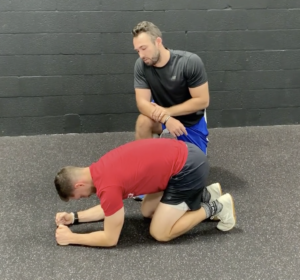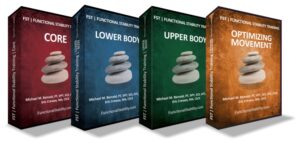
5 Things I’ve Learned About Mobility Training
It’s been 15 years since Mike Robertson and I introduced our Magnificent Mobility DVD set. This popular DVD set certainly helped a lot of people, but as with all aspects of the incredibly dynamic strength and conditioning and rehabilitation fields, we’ve learned a lot about mobility over the past decade. In other words, there are a lot of things I do differently with my training programs these days. I mean, seriously, I looked like I was 12 years old in this video.
Very simply, mobility is one’s ability to reach a desired position or posture. Because many folks erroneously confused it with flexibility (range of motion at a specific joint), the industry as a whole trended toward labeling all mobility issues as true shortness of tissues that crossed the joint(s) in question. As the years have progressed, though, we’ve smartened up to realize that folks may struggle to get to specific positions because of joint structure (e.g., femoroacetabular impingement), insufficient stiffness at adjacent joints (e.g., poor core control “presenting” as bad hip mobility), density (rather than just length) of the aforementioned tissues that cross the joint, and a host of other factors. To be more succinct, mobility is dependent on much, much more than just tissue length!
1. Soft tissue work is important, even if we don’t know exactly why.
I’m honestly entertained when I hear someone insist that foam rolling is the devil, and we should never do it. People feel and move better after they do it, and it always seems to improve the quality of mobility initiatives that take place subsequently.
I certainly don’t think it’s truly mechanically breaking down scar tissue, but it’s absolutely transiently reducing stiffness in the targeted tissues via one or more of a number of other mechanisms. Just because we can’t explain them in complete certainty doesn’t mean that “good” isn’t being done.
2. Breathing can reduce bad stiffness and establish good stiffness.
This point could also be called, “The yoga folks have been right about breathing for a long time.”
It’s not uncommon to incorporate positional breathing drills that will transiently improve both flexibility and mobility. To me, that’s an indicator that we’re both reducing bad stiffness and establishing good stiffness. As an example, take all fours breathing in a flexed position:
I’ve utilized this with athletes and seen supine shoulder flexion range of motion increase by 10-15 degrees in a matter of 15-20 seconds without actually stretching the shoulder anywhere near its end-range. Additionally, scapular upward rotation (which takes place against gravity) usually improves a bit, presumably because of both the increased recruitment of serratus anterior (which helps preserve the convex/concave relationship of the rib cage and scapula) and reduced downward pull of the lats. Again, this is very much a theory, but it’s consistently being tested with great results in our training each day. And, it’s much easier than doing loads of manual therapy and time-consuming static stretching (although there are still places for both of those initiatives).
3. Not everyone conforms to the joint-by-joint approach.
The joint-by-joint approach was first introduced by Gray Cook and developed further by Mike Boyle. The concept is very sound: the body is a system of joints/segments that alternate in the need for mobility or stability. For instance, the ankles need mobility, the knees need stability, the hips need mobility, the lumbar spine needs stability, the thoracic spine needs mobility, the scapula needs stability, etc. This all makes a ton of sense, especially in the general population that is more predictable.
However, there are some glaring exceptions to this rule. You’ll see folks with hypermobile hips, and excessively stiff lumbar spine segments. You’ll observe thoracic spines that are so flat/extended that they shouldn’t be mobilized, and shoulder blades that are so locked down that they demand more mobility training to achieve optimal function. Shoulders and elbows can really go either way.
The point is not that the joint-by-joint approach doesn’t hold water; it’s actually a tremendously useful paradigm I use on a daily basis. Rather, the point is that you can’t “one-size-fits-all your mobility approaches.” Everyone needs something slightly different, and every joint really needs a combination of mobility and stability.
4. A lot of people mistake laxity (or, worse yet, instability) for mobility.
Building on my last point, you’ll find a lot of people who have so much congenital laxity that they don’t need any stretching. Their mobility training is really a matter of attention to soft tissue quality and stability training.
The problem with these folks is that they can often “cheat the tests.” For example, they might have unbelievably perfect overhead squats and shoulder mobility to the naked eye, but if you actually pair these tests up with stability-oriented screens, they may fall well short of what you’d deem “acceptable” movement.
Instability – or an acquired, excessive joint range of motion – is even more problematic. This is where folks will literally “blow out” their normal anatomy to acquire a desired range of motion. An example is the anterior shoulder capsule in throwers; they’ll do whatever they can to get the arm back to help generate range-of-motion to support velocity production. Eventually, the shoulder can get so loose that the active restraints (rotator cuff and biceps tendon) can’t effectively hold the ball on the socket, and pain occurs with throwing.
In consideration of both laxity and instability, just because you can get to a position does not mean that you’re sufficiently stable in that position.
5. Building and maintaining mobility is like managing a bank account.
It goes without saying that it’s easier to maintain mobility than it is to lose it and get it back. Everyone uses the analogy of babies and young children having freaky range of motion and perfect squat patterns, but losing them as time progresses. The assumption is that this occurs because they “make enough deposits:” targeted mobility work and a wide variety of activities throughout their days. Certainly, this is an issue, but I’d argue that it’s because of excessive withdrawals, too.
Withdrawals could be sports participation where eccentric stress or direct trauma to tissue beats them down. It could be lifestyle factors like alcohol or tobacco use that negatively impact tissue quality. It could be pushing through faulty movement patterns until bone spurs result. What we take out is just as important as what we put in.
We all start with some money in the bank as children, but it’s up to us to have more deposits than withdrawals in this mobility account over the course of the lifespan.
These are really just a few of many observations I’ve made over the years; there are countless more that could turn this article into an entire novel! With that said, if you’re looking for both some governing principles on this front – and specific examples across the entire body – I’d recommend you check out Functional Stability Training.








